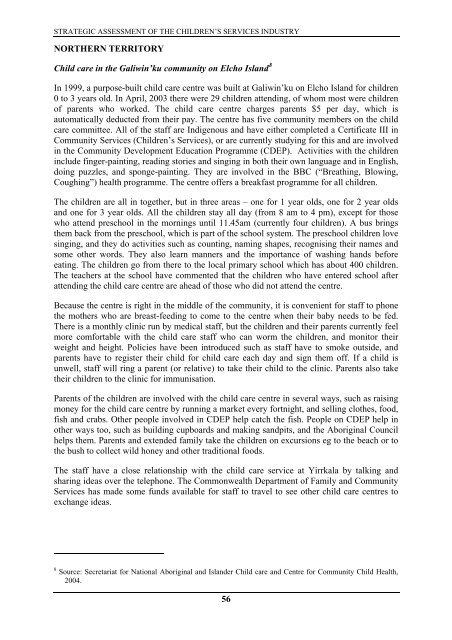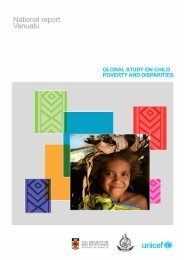A Strategic Assessment of the Children's Services Industry
A Strategic Assessment of the Children's Services Industry
A Strategic Assessment of the Children's Services Industry
- No tags were found...
You also want an ePaper? Increase the reach of your titles
YUMPU automatically turns print PDFs into web optimized ePapers that Google loves.
STRATEGIC ASSESSMENT OF THE CHILDREN’S SERVICES INDUSTRYNORTHERN TERRITORYChild care in <strong>the</strong> Galiwin’ku community on Elcho Island 8In 1999, a purpose-built child care centre was built at Galiwin’ku on Elcho Island for children0 to 3 years old. In April, 2003 <strong>the</strong>re were 29 children attending, <strong>of</strong> whom most were children<strong>of</strong> parents who worked. The child care centre charges parents $5 per day, which isautomatically deducted from <strong>the</strong>ir pay. The centre has five community members on <strong>the</strong> childcare committee. All <strong>of</strong> <strong>the</strong> staff are Indigenous and have ei<strong>the</strong>r completed a Certificate III inCommunity <strong>Services</strong> (Children’s <strong>Services</strong>), or are currently studying for this and are involvedin <strong>the</strong> Community Development Education Programme (CDEP). Activities with <strong>the</strong> childreninclude finger-painting, reading stories and singing in both <strong>the</strong>ir own language and in English,doing puzzles, and sponge-painting. They are involved in <strong>the</strong> BBC (“Breathing, Blowing,Coughing”) health programme. The centre <strong>of</strong>fers a breakfast programme for all children.The children are all in toge<strong>the</strong>r, but in three areas – one for 1 year olds, one for 2 year oldsand one for 3 year olds. All <strong>the</strong> children stay all day (from 8 am to 4 pm), except for thosewho attend preschool in <strong>the</strong> mornings until 11.45am (currently four children). A bus brings<strong>the</strong>m back from <strong>the</strong> preschool, which is part <strong>of</strong> <strong>the</strong> school system. The preschool children lovesinging, and <strong>the</strong>y do activities such as counting, naming shapes, recognising <strong>the</strong>ir names andsome o<strong>the</strong>r words. They also learn manners and <strong>the</strong> importance <strong>of</strong> washing hands beforeeating. The children go from <strong>the</strong>re to <strong>the</strong> local primary school which has about 400 children.The teachers at <strong>the</strong> school have commented that <strong>the</strong> children who have entered school afterattending <strong>the</strong> child care centre are ahead <strong>of</strong> those who did not attend <strong>the</strong> centre.Because <strong>the</strong> centre is right in <strong>the</strong> middle <strong>of</strong> <strong>the</strong> community, it is convenient for staff to phone<strong>the</strong> mo<strong>the</strong>rs who are breast-feeding to come to <strong>the</strong> centre when <strong>the</strong>ir baby needs to be fed.There is a monthly clinic run by medical staff, but <strong>the</strong> children and <strong>the</strong>ir parents currently feelmore comfortable with <strong>the</strong> child care staff who can worm <strong>the</strong> children, and monitor <strong>the</strong>irweight and height. Policies have been introduced such as staff have to smoke outside, andparents have to register <strong>the</strong>ir child for child care each day and sign <strong>the</strong>m <strong>of</strong>f. If a child isunwell, staff will ring a parent (or relative) to take <strong>the</strong>ir child to <strong>the</strong> clinic. Parents also take<strong>the</strong>ir children to <strong>the</strong> clinic for immunisation.Parents <strong>of</strong> <strong>the</strong> children are involved with <strong>the</strong> child care centre in several ways, such as raisingmoney for <strong>the</strong> child care centre by running a market every fortnight, and selling clo<strong>the</strong>s, food,fish and crabs. O<strong>the</strong>r people involved in CDEP help catch <strong>the</strong> fish. People on CDEP help ino<strong>the</strong>r ways too, such as building cupboards and making sandpits, and <strong>the</strong> Aboriginal Councilhelps <strong>the</strong>m. Parents and extended family take <strong>the</strong> children on excursions eg to <strong>the</strong> beach or to<strong>the</strong> bush to collect wild honey and o<strong>the</strong>r traditional foods.The staff have a close relationship with <strong>the</strong> child care service at Yirrkala by talking andsharing ideas over <strong>the</strong> telephone. The Commonwealth Department <strong>of</strong> Family and Community<strong>Services</strong> has made some funds available for staff to travel to see o<strong>the</strong>r child care centres toexchange ideas.8 Source: Secretariat for National Aboriginal and Islander Child care and Centre for Community Child Health,2004.56
















